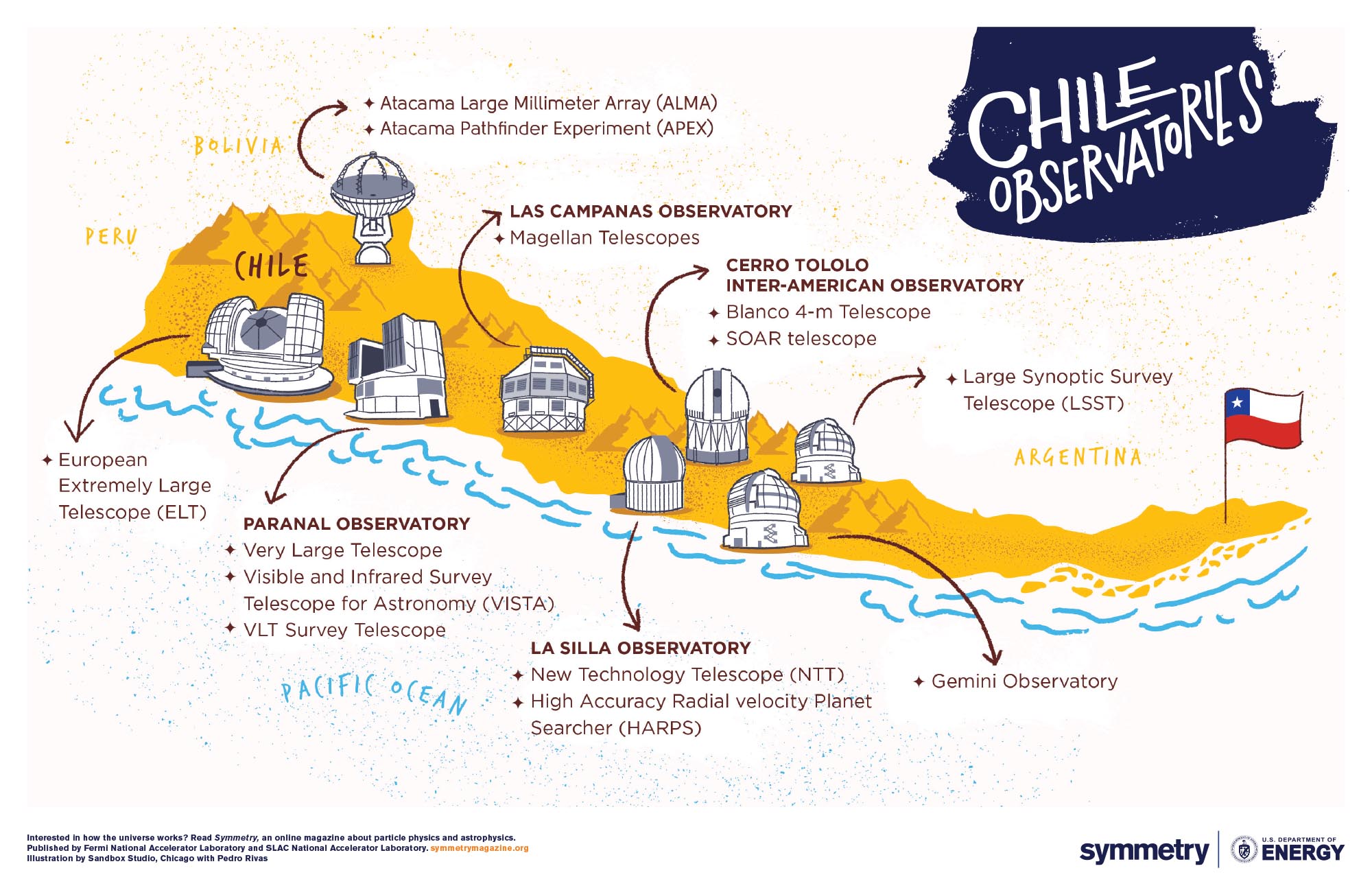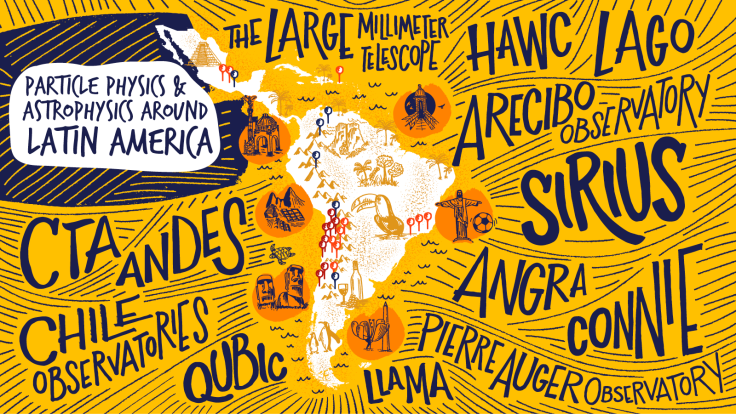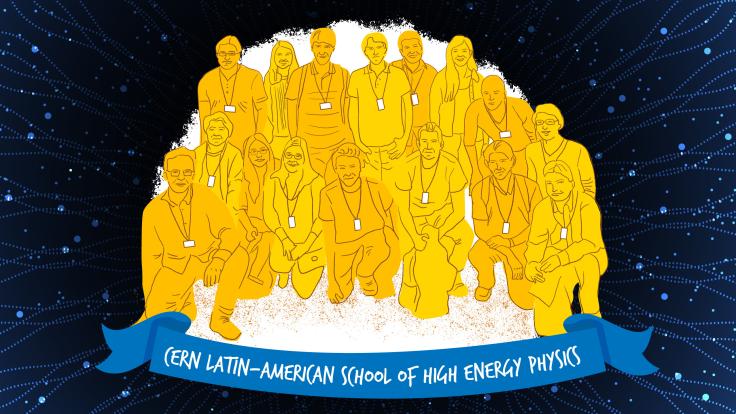In 2000 Ingo Allekotte sat behind a table in Malargüe, a city with a population of fewer than 18,000 in the foothills of the Andes mountains in Argentina, listening to an informal lecture about particles from space. It would have been an unremarkable occasion for Allekotte, a scientist—except that the venue was not a university; it was a restaurant, and the speaker was not a scientist, but a waiter. He just happened to have learned about astrophysics because of where he lives and the people who come to visit.
Attracted by a combination of environmental factors, people like Allekotte had come to Malargüe to install an array of detectors to collect signals from these particles, called cosmic rays.
They weren’t the only ones to choose Latin America as the base for their studies of what lies beyond Earth’s atmosphere. An influx of researchers from around the world has made its mark on science, technology, culture and people in Latin America—including at least one restaurant employee. This is especially true in Malargüe, home to the Pierre Auger cosmic ray observatory, and across Chile, a country with more astronomical observatories than any other.
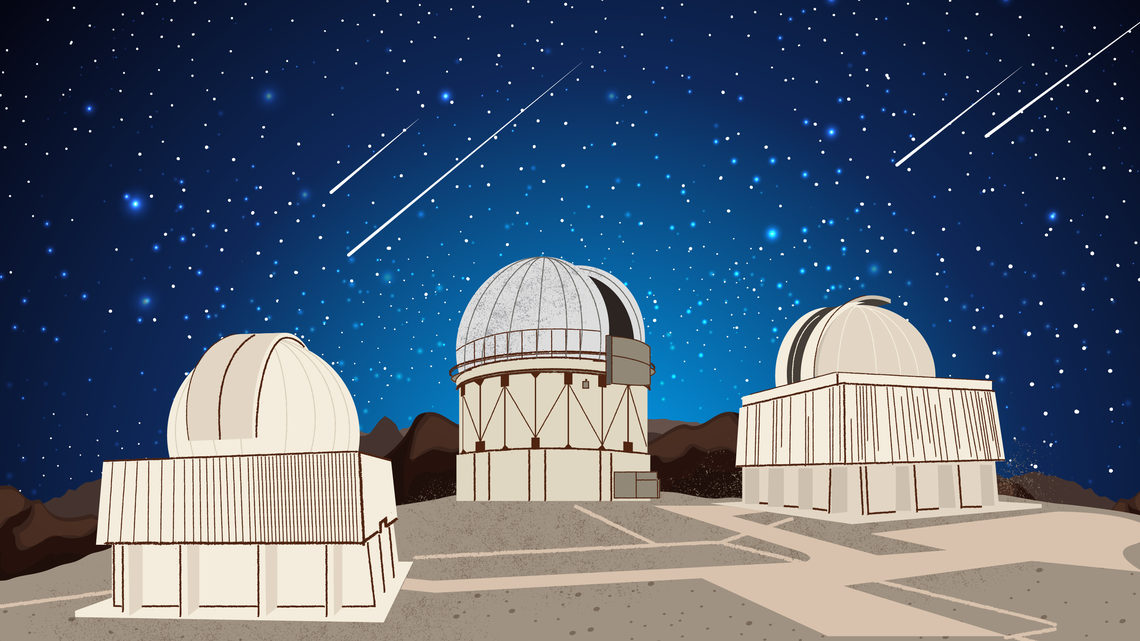
A hub for astronomy
Northern Chile’s Atacama Desert could easily be mistaken for the surface of another world. Sparse rainfalls make the Atacama one of the most arid regions on Earth, giving it the parched, barren conditions you would expect to find on Mars.
The Atacama stretches for hundreds of miles between a high coastline in the west and the Andes Mountains in the east. Because of its unique location, the desert has clear skies more than 90% of nights during the year with barely any water vapor in the atmosphere.
“When you put it all together, you get these unique conditions that explain why the Atacama is the best place in the world to put telescopes,” says Ezequiel Treister, an astronomer at the Pontifical Catholic University of Chile.
Currently, the Atacama and the nearby Chilean Andes are home to more than half a dozen scientific astronomical observatories. Once construction of the Large Synoptic Survey Telescope (LSST), the European Extremely Large Telescope (E-ELT) and the Giant Magellan Telescope (GMT) are complete, Chile will be home to around 70% of the total astronomical resources in the world.
Chile’s impeccable night sky has drawn interest from the international scientific community for more than a century. As far back as the 1800s, astronomers from the United States and Europe set out on scientific expeditions to the South American country and helped establish a handful of local astronomical observatories in the region.
In the 1960s, the University of Chile and the US National Science Foundation (NSF) joined forces with the Association for Universities for Research in Astronomy (AURA) to establish the Cerro Tololo Inter-American Observatory (CTIO). This complex of astronomical telescopes and instruments, built in the mountains that skirt the southern edge the Atacama, became Chile’s first large, international observatory. Shortly after, the European Southern Observatory (ESO) built the La Silla Observatory, one of several sites it now operates in the country.
The building boom of observatories that started almost six decades ago is still ongoing today. “The development of astronomy in Chile over the last few decades has been really exponential,” Treister says. “We are very well connected with institutes worldwide, mostly those in the US, Europe and Asia.”
Work conducted at Chilean observatories has contributed to major scientific advances, such as the 1998 discovery that the universe is expanding at an accelerating pace—an insight that led to the study of dark energy—along with the recent first-ever image of a black hole. “It’s really hard for me to think of a single astronomical milestone in the last 20 to 30 years that didn’t involve observatories in Chile,” Treister says.
The trend has contributed to the development in Chile of new astronomy-related university programs and a growth in the number of professional astronomers there. Monica Rubio, an astronomer and the president of the Chilean Astronomical Society (SOCHIAS), recalls that when she enrolled in graduate school in the 1980s, there were no astronomy PhD programs in Chile; she had to go abroad to France to obtain a doctoral degree.
Today, the situation has drastically changed. Over the last few decades, funding provided by both the Chilean government and the international observatories operating in the country has allowed more institutions to offer undergraduate, master’s and PhD programs in astronomy, Rubio says. “We have gone from three universities doing astronomy in 2000 to today where we have 15 universities, more than 200 astronomers and hundreds of students,” she says. “The increase in numbers has been amazing.”
Agreements signed by the observatories to reserve at least 10% of their observing time for academics working at Chilean institutions has helped boost science in the country. “We benefited a lot from the dedicated observing time,” says Ricardo Finger, an engineer at the University of Chile’s Millimeter-wave Laboratory. “Astronomy has developed at a very fast rate, and it's now one of the most important sciences in Chile.”
Technology transfer
At the Millimeter-wave Laboratory, a multidisciplinary group of astronomers, engineers and technicians works on developing astronomical technologies. This includes building receivers for radio telescopes and generating algorithms for data processing.
In recent years, the laboratory has also been searching for ways to apply its technologies for more widespread use by Chilean industries. One device the team developed uses a phased array technique found in radio telescopes to detect cellular phone signals. The gadget generates a map of electromagnetic radiation in the environment somewhat like a thermal camera generates a heat map of its surroundings.
“The idea was that if you have this camera, you can look into a field and know if there is, for example, a cellphone transmitting, even if it’s hidden,” Finger explains. “That could be useful in different fields, such as search and rescue—especially in Chile, which is a very earthquake-active country.”
The lab also designed a device that can sense temperature and moisture level of soil and transfer that data to a location several kilometers away. The tool is especially useful for the mining industry, Finger explains, which uses a process called “leaching” to extract metals such as copper by pouring a solution of water and acid onto a massive pile of rock. If there is too much water present in the soil, the acid-water mixture can spill over into the surroundings. Too little water, on the other hand, can lead to inefficient extraction.
“A number of companies want to represent this product,” Finger says. “After a few years of trial and error, that’s the first success case we had.”
The team has built a handful of other devices, and it is still on the lookout for additional ways to apply their technology outside of the observatory, Finger says. “There will be new ideas for sure.”
The growth in large observatories—and the massive amounts of data generated from them—has also helped Chile develop advanced tools for big data and astroinformatics.
These technologies will likely get a further boost when LSST, a telescope fitted with the largest digital camera in the world, is complete in the early 2020s. To provide a deep and detailed survey of the universe, the massive telescope being built by NSF will collect some 30 terabytes of data each night.
“The amount of data that LSST will collect is going to be unprecedented,” Rubio says. An advantage of developing technologies to manage this influx of information, she adds, is that “the tools that are required for big data analysis can be easily applied to other disciplines, such as medicine, retail and finance.”
The Chilean government recently launched the “Data Observatory,” an initiative to gather, analyze and store large data sets generated in the country. They plan to use astronomy data as the first test case for this project, which will be carried out in collaboration with Amazon Web Services and Adolfo Ibáñez University.
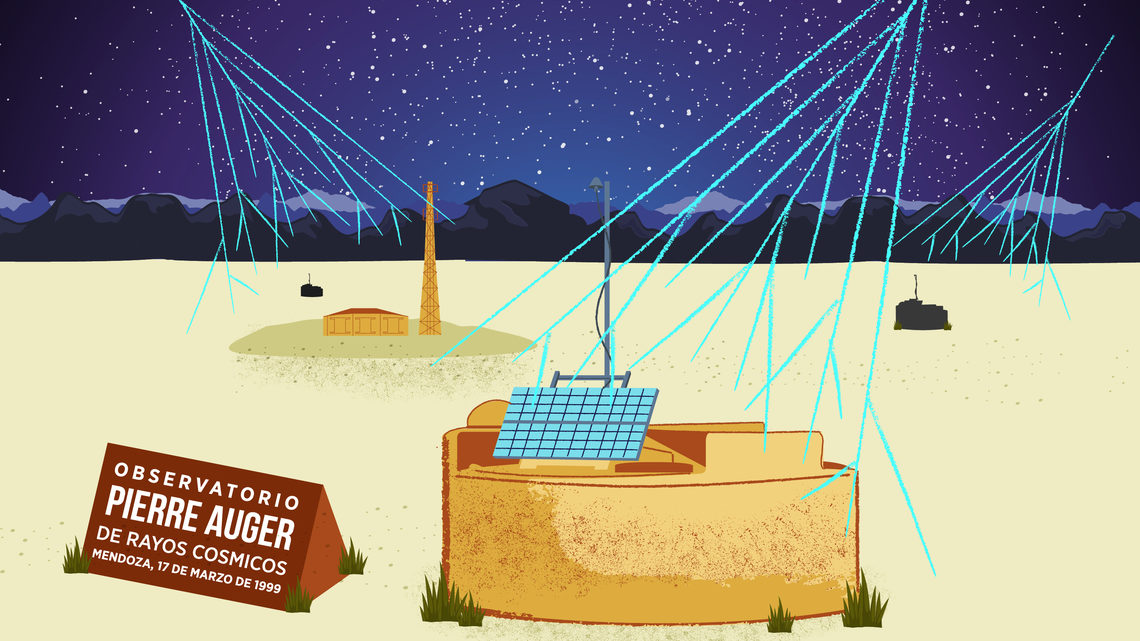
A unique observatory in Argentina
In 1992, physicists Jim Cronin, a Nobel laureate and professor at the University of Chicago, and Alan Watson, a professor at the University of Leeds in the UK, proposed building a massive observatory to investigate cosmic rays that crash to Earth at unbelievably high energies.
These very-high-energy particles are rare and therefore hard to catch, so the scientists wanted their array of instruments to cover as much ground as possible. Scientists had built cosmic-ray observatories before, but none possessed the collecting power that Cronin and Watson were looking for.
To make this vision a reality, Cronin spearheaded efforts to spread enthusiasm for the project worldwide, which eventually led to an international collaboration. In 1998, after a series of workshops, the group chose a spot just outside of Malargüe in Argentina as the site for their ambitious cosmic-ray observatory, which they named after French cosmic-ray researcher Pierre Auger.
Malargüe was an optimal location for several reasons, says Allekotte, the current project manager at the Pierre Auger Observatory. First of all, the city, which is located in the foothills of the Andes mountains, is surrounded by a very flat area. Being fairly isolated (more than 100 kilometers, or 60 miles, from the next city) and small, it emitted almost no light or air pollution. In addition, previous uranium and oil exploration and extraction projects in the region had left some basic infrastructure, such as roads, already in place. And the mayor of Malargüe was on board with the project.
Construction was completed in 2008. The array is now 3000 square kilometers (more than 1000 square miles) in size and consists of more than 1600 detectors.
The observatory uses two different methods for detecting cosmic rays: “surface detectors,” which track particles that pass through large water-filled tanks, and “fluorescence detectors,” which pick up on the ultraviolet light emitted when cosmic particles interact with nitrogen in Earth’s atmosphere.
Argentinian scientists and engineers have played a major role in both the construction of Pierre Auger and the ongoing research at the observatory. According to Allekotte, approximately 10 to 15 percent of the institutions the observatory hosts are from Argentina. The rest are from 16 other countries.
Carla Bonifazi, a physicist at the Federal University of Rio de Janeiro, says that she chose to complete her doctoral studies at Pierre Auger because it allowed her to work on the first big international particle physics collaboration in Argentina. “This was a big opportunity,” Bonifazi says. “I was there at the right moment.”
Soon after Pierre Auger commenced operations, the National University of Cuyo—which is based in Mendoza, a large city 400 kilometers (approximately 250 miles) away from the observatory—opened a regional branch in Malargüe. “This is not necessarily related to the observatory, but I think the fact that the observatory was there had a strong influence,” Allekotte says. “And often engineers and scientists working at the observatory teach at the university.”
In addition to cosmic-ray physics, scientists and engineers at Pierre Auger have been involved with several side projects. They have worked on atmospheric monitoring programs using instruments set up on site, and they have provided services and infrastructure for seismic projects and satellite programs. “When we set up such an observatory, it turns out to have quite some byproducts that make it interesting and multidisciplinary,” Allekotte says.
A small, international city
Since Pierre Auger’s launch, Malargüe’s population has continued to grow; today more than 27,000 people call it home. Many foreign scientists have travelled to the city to work at the observatory. Once or twice a year, more than 100 international collaborators gather there for scientific meetings.
“When the observatory started, all the international visitors going to the restaurants and hotels and walking on the streets were a bit strange for the people of Malargüe,” says Gualberto Ávila, the site manager at Pierre Auger Observatory.
Still, staff at Pierre Auger have made efforts to encourage such interactions. “In the beginning, we thought about having guest rooms for visiting scientists on site,” Allekotte recalls. “But we then discarded this idea and decided to get people who come to the observatory rent their apartment or housing in the town.”
Allekotte believes that was a good decision because this allowed for foreign academics to interact more closely with the people in the town of Malargüe—leading to, for example, impromptu waitstaff science lectures.
Pierre Auger has changed the lives of citizens of Malargüe in a variety of ways.
Scientists at the observatory have donated money, books and educational materials to the local schools. In 2006, the town inaugurated the James W. Cronin School, a secondary school named after the physicist for his contributions to the local community.
When a powerline was installed to power the detectors at the observatory, many rural homes were also connected to the grid for the first time. “I think this was the most important impact for the infrastructure in the area,” Ávila says.
The Pierre Auger Observatory was initially set to run until 2015, but the international collaboration agreed to upgrade the facilities and extend its life for at least another 10 years.
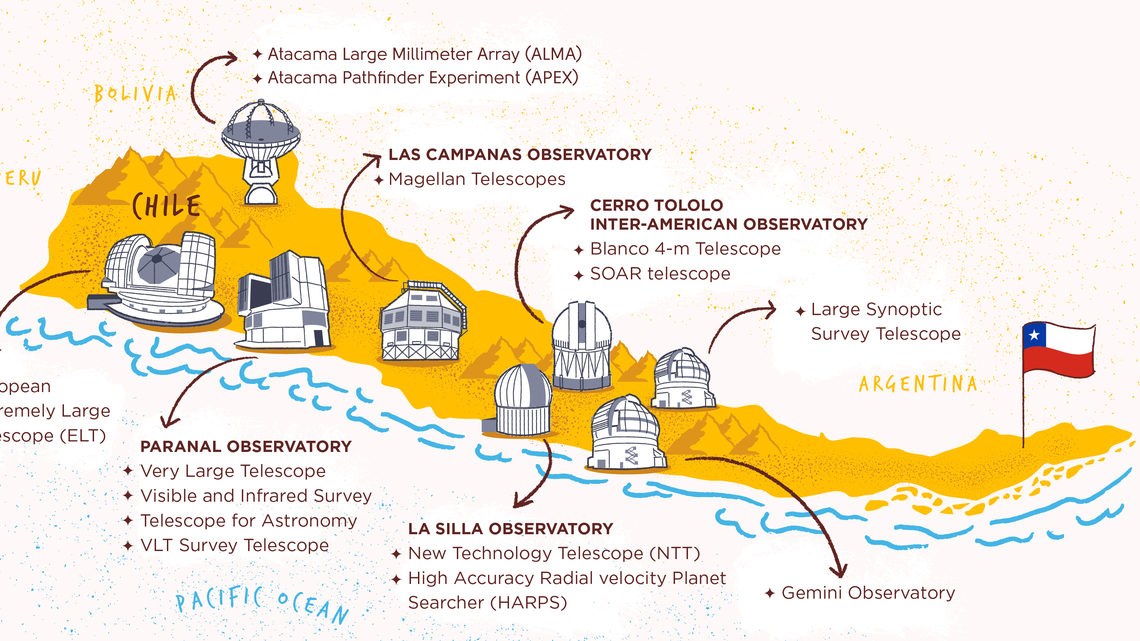
Following the science
A visitor center in Malargüe provides information about Pierre Auger Observatory and cosmic-ray physics. Since 2001 it has welcomed more than 100,000 people from both around Argentina and abroad. Science fairs held every few years by the observatory have also attracted students and teachers from all around the country.
Cosmic-ray science has seeped into everyday life in Malargüe, Allekotte says. “The city of Malargüe promotes itself as a city for scientific tourism,” he says. “The observatory plays a big role in giving the town this characteristic.”
For its part, Chile now has at least 10 tourism-specific astronomical observatories where amateur stargazers can peer through telescopes to get a closer look at the night sky. The professional observatories also consider outreach to the local community to be key to their missions.
According to Rubio, the regions that house these facilities have also benefitted economically from the influx of tourists, especially during special events, such as the total solar eclipse that passed through parts of Chile and Argentina in July 2019.
The rapid progression of astronomy in Chile has also been met by a growth public interest in the science, Rubio says. “Today, we see news about astronomy almost daily. Chile’s very good skies and astronomical facilities have become part of the national identity.”




